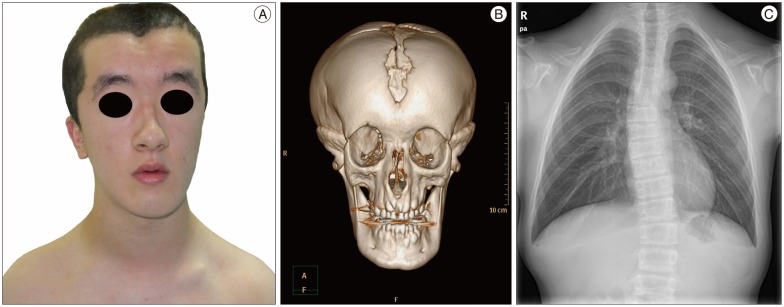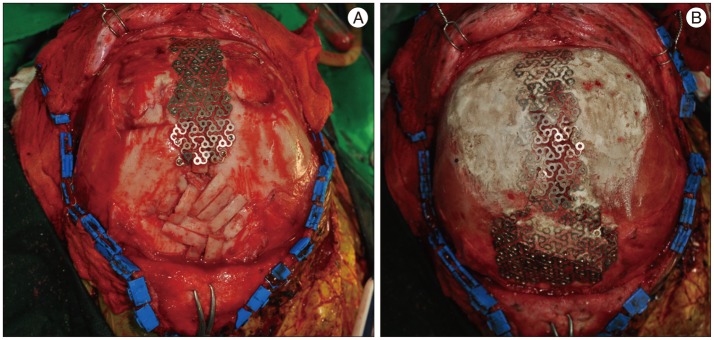J Korean Neurosurg Soc.
2015 Jul;58(1):79-82. 10.3340/jkns.2015.58.1.79.
Cranioplasty Using a Modified Split Calvarial Graft Technique in Cleidocranial Dysplasia
- Affiliations
-
- 1Department of Neurosurgery, Cheju Halla Hospital, Jeju, Korea. hixos@naver.com
- KMID: 2067110
- DOI: http://doi.org/10.3340/jkns.2015.58.1.79
Abstract
- Cleidocranial dysplasia is a well-documented rare autosomal dominant skeletal dysplasia characterized by hypoplastic/aplastic clavicles, brachycephalic skull, patent sutures and fontanelles, midface hypoplasia, and abnormalities of dentition. Patients with cleidocranial dysplasia often complain about undesirable esthetic appearance of their forehead and skull. Notwithstanding many studies of molecular, genetics and skeletal abnormalities of this congenial disorder, there have been very few written reports of cranioplasty involving cleidocranial dysplasia. Thus, we report a rare case of successful cranioplasty using a modified split calvarial graft technique in patient with cleidocranial dysplasia.
Figure
Reference
-
1. Agrawal A, Garg LN. Split calvarial bone graft for the reconstruction of skull defects. J Surg Tech Case Rep. 2011; 3:13–16. PMID: 22022648.
Article2. Artico M, Ferrante L, Pastore FS, Ramundo EO, Cantarelli D, Scopelliti D, et al. Bone autografting of the calvaria and craniofacial skeleton : historical background, surgical results in a series of 15 patients, and review of the literature. Surg Neurol. 2003; 60:71–79. PMID: 12865021.3. Baumert U, Golan I, Redlich M, Aknin JJ, Muessig D. Cleidocranial dysplasia : molecular genetic analysis and phenotypic-based description of a Middle European patient group. Am J Med Genet A. 2005; 139A:78–85. PMID: 16222673.4. Cooper SC, Flaitz CM, Johnston DA, Lee B, Hecht JT. A natural history of cleidocranial dysplasia. Am J Med Genet. 2001; 104:1–6. PMID: 11746020.
Article5. Inoue A, Satoh S, Sekiguchi K, Ibuchi Y, Katoh S, Ota K, et al. Cranioplasty with split-thickness calvarial bone. Neurol Med Chir (Tokyo). 1995; 35:804–807. PMID: 8657331.6. Kang N, Kim SZ, Jung SN. Correction of depressed forehead with BoneSource in cleidocranial dysplasia. J Craniofac Surg. 2009; 20:564–566. PMID: 19305258.
Article7. Kobayashi S, Uchida K, Baba H, Takeno K, Yayama T, Nakajima H, et al. Atlantoaxial subluxation-induced myelopathy in cleidocranial dysplasia. Case report. J Neurosurg Spine. 2007; 7:243–247. PMID: 17688067.8. McGuire TP, Gomes PP, Lam DK, Sándor GK. Cranioplasty for midline metopic suture defects in adults with cleidocranial dysplasia. Oral Surg Oral Med Oral Pathol Oral Radiol Endod. 2007; 103:175–179. PMID: 17234531.
Article9. Mundlos S. Cleidocranial dysplasia : clinical and molecular genetics. J Med Genet. 1999; 36:177–182. PMID: 10204840.10. Mundlos S, Otto F, Mundlos C, Mulliken JB, Aylsworth AS, Albright S, et al. Mutations involving the transcription factor CBFA1 cause cleidocranial dysplasia. Cell. 1997; 89:773–779. PMID: 9182765.
Article11. O'Broin ES, Morrin M, Breathnach E, Allcutt D, Earley MJ. Titanium mesh and bone dust calvarial patch during cranioplasty. Cleft Palate Craniofac J. 1997; 34:354–356. PMID: 9257028.12. Ronderos JF, Wiles DA, Ragan FA, Dempesy CW, Culicchia FC, Fontana CJ, et al. Cranioplasty using gentamicin-loaded acrylic cement : a test of neurotoxicity. Surg Neurol. 1992; 37:356–360. PMID: 1631760.
Article13. Sahoo NK, Rangan M. Role of split calvarial graft in reconstruction of craniofacial defects. J Craniofac Surg. 2012; 23:e326–e331. PMID: 22801169.
Article14. Strong EB, Moulthrop T. Calvarial bone graft harvest : a new technique. Otolaryngol Head Neck Surg. 2000; 123:547–552. PMID: 11077338.
- Full Text Links
- Actions
-
Cited
- CITED
-
- Close
- Share
- Similar articles
-
- Cleidocranial Dysostosis: One Case Report
- Sphenoid Dysplasia in the Absence of Neurofibromatosis Type I: Case Report
- Cleidocranial dysplasia: a preliminary report
- Treatment of Fibrous Dysplasia of the Fronto-Orbital Area with Radical Resection and Autogenous Reconstruction Using Split Calvarial Bone Graft: A Case Report
- Cleidocranial Dysostosis One Case Report





